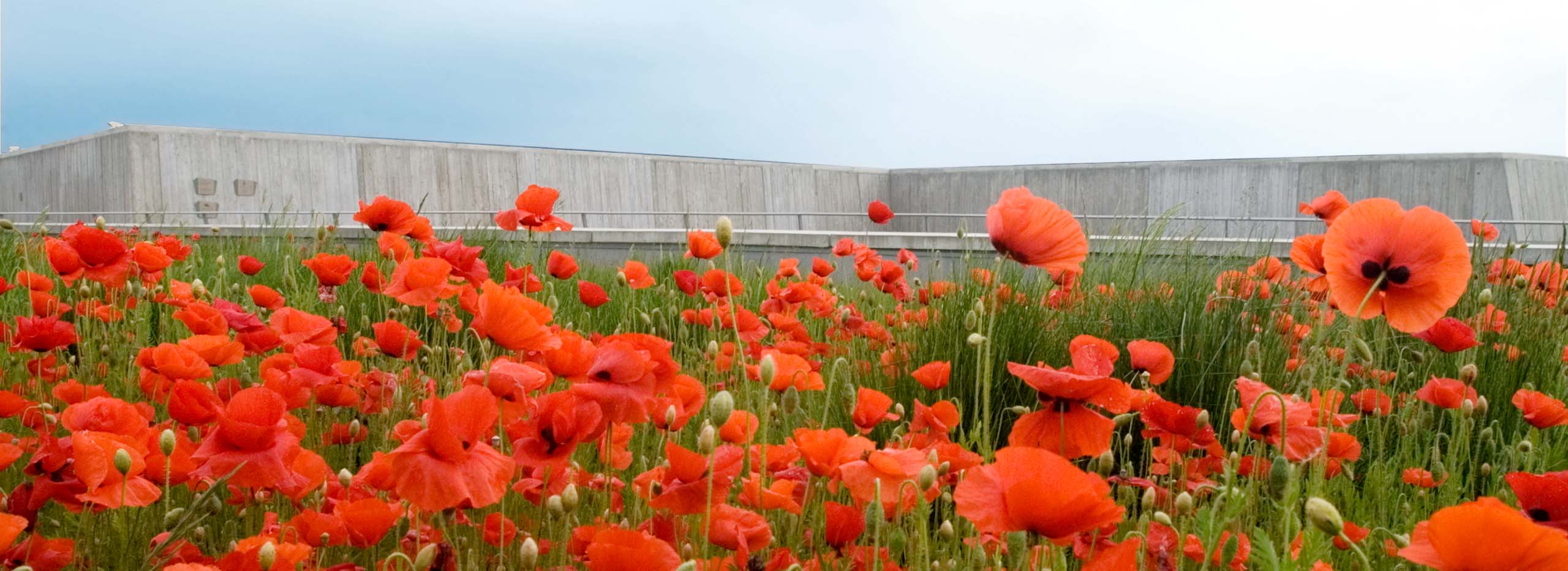Welcome to this Remembrance guided tour stop at the Canadian War Museum. My name is Kevin and I’m a museum interpreter.
The building that we’re standing in is a place where architecture, artifacts and exhibitions work together to help us understand war and its impact on all Canadians, past and present. It’s a place where we come to remember.
The War Museum is not just a place to preserve and share the story of Canada’s military past. It’s part of that story. If these walls could talk, what would they say? Let’s take a closer look at how the message of remembrance is intertwined with the architecture all around us.
Here in the Moriyama Regeneration Hall, the walls and supporting beams are sharply angled. They lean and bend like they might collapse — don’t worry, they won’t. They look off balance on purpose, to make us feel the instability of war.
But “regeneration” means renewal. This room, both solemn and uplifting, symbolizes regeneration after the destruction of war, and a renewed hope for peace.
Take the evocative sculptures. They’re original plaster models for the much larger carved stone figures on the Vimy Memorial in France. That monument, built where Canadians fought in the 1917 Battle of Vimy Ridge, is a tribute to all Canadians who served during the First World War, especially those who never came home to their families.
Inscribed on the memorial are the names of 11,285 Canadians with no known grave in France, an act of reclaiming the fallen.
The artist, Walter Allward, created 20 figures to represent virtues such as justice and honour.
These plaster maquettes were sent to France.
Stone carvers used them to create the final sculptures, which are twice as big. If you look closely, you can still see the pencil marks made by Allward himself, which were used as references for scale.
A unique architectural feature of this space is the view you have when you stand precisely where I am right now. Let’s switch places. What can you see in the distance? That’s the Peace Tower on Parliament Hill. It was built after the First World War, and is dedicated to those who fought and died in pursuit of peace.
Now, notice what happens if we move a little. Can you still see it? No? The perfect view of the Peace Tower is as elusive as peace itself.
This fleeting glimpse of the Peace Tower is a symbolic link between the Museum and the Parliament buildings. This link is important because Parliament is where Canada’s wartime decisions have been, and still are, debated. The Canadian War Museum is where we seek to understand the context and consequences of those decisions.
There’s one last little detail I’d like to share with you. Have you noticed a whistling sound in this room?
When he was 12 years old, during the Second World War, the Museum’s architect, Raymond Moriyama, was forcibly relocated to a Japanese-Canadian internment camp in the interior of British Columbia.
This racist relocation policy began in 1942, after Canada went to war with Japan, and lasted until the end of the Second World War. Over 90% of Japanese Canadians, 22,000 people, were detained, dispossessed of their property and interned under the War Measures Act.
To cope with his traumatic displacement, Raymond Moriyama built a tree house. He would sit in it and listen to the sound of the wind as it blew through the trees. It struck him as eerie, but oddly comforting. His tree house inspired him to become an architect.
Many years later, when this building was under construction, Mr. Moriyama came to this hall, which was unfinished at the time, and heard the wind whistling through it. It reminded him of the sound in his boyhood tree house, and he asked that it be recorded and used in this space.
This story is a powerful example of how the past can shape the present. Because of his experience during the Second World War, Mr. Moriyama has a unique and authentic perspective that he brought to the design of this amazing space.
And this space, the Moriyama Regeneration Hall, is a physical representation of hope for a better future.

